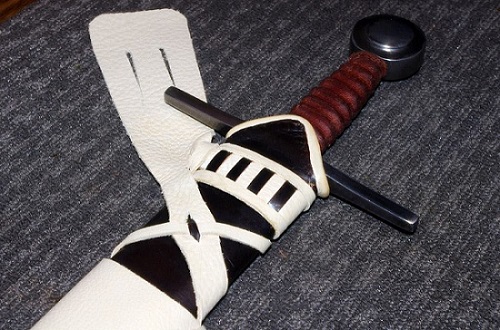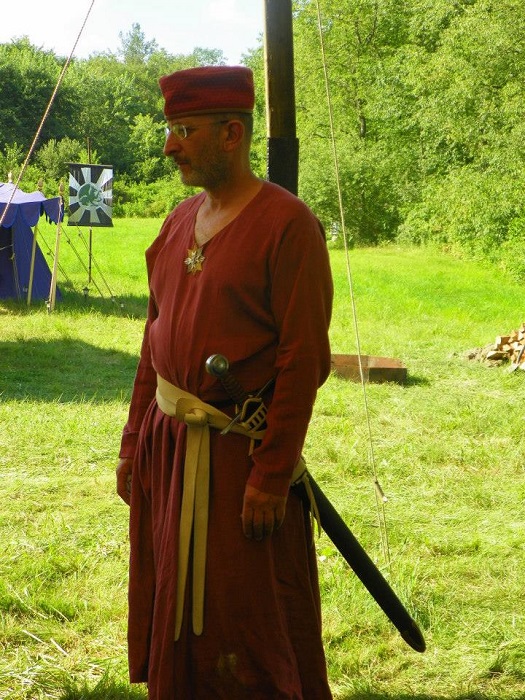Hi All,
I have just uploaded a couple of videos showing how to tie early sword belts or buckle longsword belts.
Simple stuff, but useful to know.
I hope you like them.
Tod
https://www.youtube.com/watch?v=cuYVQk1SO0o
https://www.youtube.com/watch?v=A2OeMstdna0
These videos are perfectly done. They're clear and concise. I hope to see more!
Short and sweet! Excellent job on the tied belt, and a knot which is frequently seen in armoring.
Awesome! This helps a lot since I have one of your belts from the first video. Would anything change in harness or on a horse for the longsword belt, specifically placement of the belt itself? (not that I ride my horse with a longsword or have any armor...)
Thanks again!
Thanks again!
Are there any historical references for the method of tying the thong belt?
I have been tying my belt like that for a few years now, after looking at some of the images on manuscript miniatures. Based on the images catalogued there, it looks like there were a few different ways to tie ones belt, but the method in the video is the one I like best, because it is pretty secure and has a nice quick-release feature.
Thanks guys and glad to be of service.
What do you mean by a 'thong belt' Harry?
Tod
What do you mean by a 'thong belt' Harry?
Tod
I've always seen that type of sword belt called a "thong belt," as opposed to a buckled belt
I've always tied an overhand slip knot with a loop of both tails, but I have no specific reference for that knot. I like your knot better, it's more compact.
Wondering if you have a "period" reference for that knot or just found it by experimentation.
I've always tied an overhand slip knot with a loop of both tails, but I have no specific reference for that knot. I like your knot better, it's more compact.
Wondering if you have a "period" reference for that knot or just found it by experimentation.
I tried this method for a couple of weeks while at Pennsic, and I love it.
Here is a scabbard that I made last year with a "thong" belt. It is an exact reproduction of a German scabbard from C. AD 1220
 Attachment: 92.48 KB
Attachment: 92.48 KB

Here is a scabbard that I made last year with a "thong" belt. It is an exact reproduction of a German scabbard from C. AD 1220

These are excellent.
| Harry Marinakis wrote: |
| Wondering if you have a "period" reference for that knot or just found it by experimentation. |
Most of the period artwork that illustrates this type of belt shows it tied in just this fashion. One such source is provided in the video itself.
| Patrick Kelly wrote: |
| Most of the period artwork that illustrates this type of belt shows it tied in just this fashion. One such source is provided in the video itself. |
Actually - not really.
There are many ways to tie a knot so that it looks like the knots depicted in the illuminations. I tie a different knot that ends up looking the same as Tod's knot.
Is there any evidence for one specific knot versus another?
I've experimented with a lot of different knots to try to reproduce what I saw in the illuminations. The belt leather in the illuminations is very soft, almost cloth-like. Most people nowadays use a veg tan leather, which is far too stiff to accurately reproduce the knots in the illuminations. I found that modern oil-tanned Latigo works best for these types of belts, since it is soft and doesn't stretch.
Here's a picture of my knot with a very soft Latigo belt. Can you tell the difference between my knot and Tod's knt?
EDIT: Actually I think this is Tod's knot depicted here.

good videos!
I agree that this method from the first movie is most common in medieval sources - we can see it many times at very precise illustrations - but for the "dragon`s tongue belt" style - certainly it was not only method :)
I know some more historical methods for tying this kind of belt - according to medieval sources - some of them shows very precisly minimum 2 more ways for this - also very effective.
one more thing - there is a better way to start tying - much faster and easier but hard to describe... I will try to show this soon.
in my opinion the point was to make it quick, effective and not to easy to take it off accidentally...
we also need to realize that this style of belt design was most popular through over two centuries - so, it had to be very good for sword carrying and very easy to make by craftsmans or even users themselves - for example to replace damaged one...
I agree that this method from the first movie is most common in medieval sources - we can see it many times at very precise illustrations - but for the "dragon`s tongue belt" style - certainly it was not only method :)
I know some more historical methods for tying this kind of belt - according to medieval sources - some of them shows very precisly minimum 2 more ways for this - also very effective.
one more thing - there is a better way to start tying - much faster and easier but hard to describe... I will try to show this soon.
in my opinion the point was to make it quick, effective and not to easy to take it off accidentally...
we also need to realize that this style of belt design was most popular through over two centuries - so, it had to be very good for sword carrying and very easy to make by craftsmans or even users themselves - for example to replace damaged one...
HI All,
Thanks for the feedback and the unexpected amount of interest.
This method is one that I worked out years ago and was quite happy with it and looked like the artwork, so was happy with that.
Tod
Thanks for the feedback and the unexpected amount of interest.
This method is one that I worked out years ago and was quite happy with it and looked like the artwork, so was happy with that.
Tod
| Maciej K. wrote: |
| - according to medieval sources - |
I would love to see the sources if you can find them.
Thanks
Page 1 of 1
You cannot post new topics in this forumYou cannot reply to topics in this forum
You cannot edit your posts in this forum
You cannot delete your posts in this forum
You cannot vote in polls in this forum
You cannot attach files in this forum
You can download files in this forum
All contents © Copyright 2003-2006 myArmoury.com — All rights reserved
Discussion forums powered by phpBB © The phpBB Group
Switch to the Full-featured Version of the forum
Discussion forums powered by phpBB © The phpBB Group
Switch to the Full-featured Version of the forum